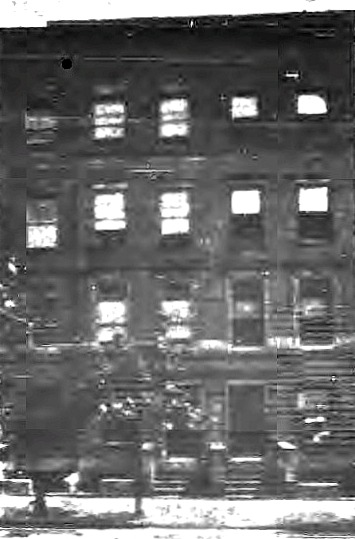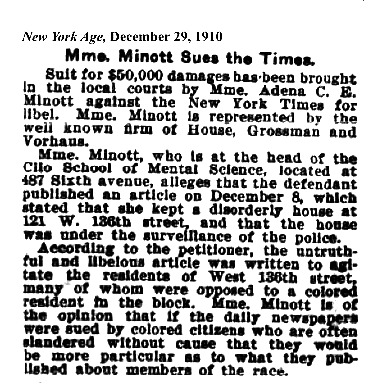
vs. the New York Times
In December 1910 the New York Times printed an item about the movement of Black property owners into areas previously predominently White owned. There was particular mention of Adena Minott as an owner, with the accusation that her property at 121 West 136th Street had housed 'disorderly persons'. Miss Minott took legal action against the Times for what she considered a libel. I am still trying to get all the facts on this interesting legal challenge.

|
|
121 West 136th Street |
New York Age, April 25, 1912
p 1
BREAK COVENANT IN 136TH STREET
Negroes Buy Property in Harlem Supposed to be Restricted
WHITES ARE SURPRISED
Minott Family Moves into 135 W. 136th St. and Causes Excitement by Returning to Block
AGREEMENT A BIG JOKE
Mrs. Anna Liebe who Sold Property to Minotts says She Does Not Think Very Much of the Covenant.
There was great excitement in West 136th street, between Lenox and Seventh avenue, Tuesday afternoon when the white property owners learned that Negroes had purchased the residence at 135 West 136th street, known as one of the covenant houses. As the original owners some months ago had signed the covenant not to sell or lease the premises to colored people the whites of the block were given quite a shock when it was learned that the agreement had been broken.
There were also other surprises handed the white property owners. One was that the property at 135 West 136th street had been bought by J. Anthony Minott, brother of Mme. Adena C. E. Minott, who unconsciously created much unnecessary excitement over a year ago when she purchased the house at 121 West 136th street, which was one of the principal reasons of the white residents for drawing up a covenant not to sell or rent any of the property in the block to Negroes.
The Minott family moved from 121 W. 136th street last February, having sold the property, and there was much rejoicing in the block. John G. Taylor, whose activity and officiousness has made him a nuisance to many colored property owners in the vicinity, caused to be placed in 121 West 136th street after the Minott family had moved out signs in ail the windows that the house was for rent and was restricted. Articles were put in several of the local papers that the Minotts were compelled to give up the property because of a foreclosure, which was promptly denied by them. So jubilant was a little white sheet published in Harlem over the moving of the Minotts that it gave undue prominence to the incident.
That the Minotts now have the laugh on the white property owners has been obvious since they took possession Tuesday. One of the humorous features in the case is that the new residence is next to the property owned by the first man to sign the covenant to keep Negroes out of the block. Since the arrival of his new neighbors his disposition has not been sunny and congenial.
The first intimation the white owners had of the presence of colored neighbors was when the moving vans stopped at 135 West 136th street and Mme. Adena C. E. Minott was seen superintending the placing of the furniture. She was soon recognized by her former neighbors, and when asked timidly by one of them if she had bought the property she emphatically answered in the affirmative.
The news that the Minotts had come back quickly spread, and the fact that they were located in the center of the block and in "restricted" property was soon heralded about. The members of the Harlem Property Owners' Association assembled in groups and discussed the return of the Minotts in animated fashion.
What seems to be a bitter pill for the signers of the covenant to swallow is that the sale of the property at 135 West 136th street marks the breaking of the farcical agreement made to keep colored people out of the block. Although the majority of them knew that such an instrument would not stand a test if its legality was ever questioned in the courts, they thought that by giving the covenant much publicity it would tend to keep the colored people from buying property in the block and adjacent territory.
The property was bought of Mrs. Anna Liebe, who, while knowing of the existence of the covenant, says she had a right to sell it to any person she saw fit, remarking that she regarded the covenant as a big joke.
The Minotts assert that while they are not looking for notoriety they intend to buy property wherever they desire and do not intend to be thwarted by prejudiced whites who are afflicted with the colorphobia.

135 West 136th Street


